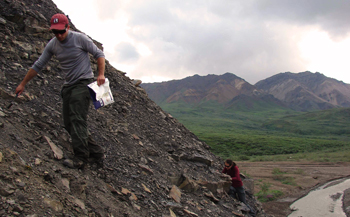
Photo by David Sunderlin
One of the most interesting chapters in Earth history is the Late Cretaceous (~70 million years ago). It was a time of peak dinosaur biodiversity during a globally warmer world. It was also a time of important evolutionary and ecological changes in the composition of ancient forests. The Late Cretaceous ecosystems occurred geologic moments before the major earth catastrophe known as the Cretaceous/ Tertiary extinction, which wiped out more than 50% of marine species and had huge repercussions for land ecosystems as well.
The Cantwell Formation rocks exposed in Denali reveal to scientists “a few lines” from this interesting and remarkable Late Cretaceous chapter of history.

Photo by David Sunderlin
Colliding Terranes and Deposition of Sediments
Alaska is a geologically active region of North America. Over millions of years, the region has been formed and transformed by colliding blocks (plates) and smaller units of Earth’s crust (“terranes”). As these collide, they produce mountains that erode into basins that flank them. In the Late Cretaceous, many of the terranes had formed rugged topography similar to the majestic Alaska Range of today.
Sediments shed off of these rising mountains in the Cretaceous made their way to the lowlands via rivers and wind and were deposited in many ancient basins including the “Cantwell Basin.” The sands, gravels, and muds that were deposited in lakes and streams in this part of Central Alaska supported a flourishing ecosystem, the remains of which are preserved in the basin sediments. These sediments have been tilted, rearranged, and revealed through erosion as scenery along the park road.
Studying Cretaceous Ecosystems in Denali
Dr. David Sunderlin of Lafayette College in Pennsylvania, along with the National Park Service geologists and scientists from several institutions, is working to reveal more about this Late Cretaceous chapter exposed in the basin sediments of the lower Cantwell Formation.
The goals of the collaborative project are to study the full ecosystem preserved in the Cantwell Formation and similar strata throughout central Alaska. This rare glimpse into the plant, vertebrate, invertebrate, and environmental records all in one place allows for one of the most complete investigations in the world of a Late Cretaceous ecosystem at high latitudes. Not only does the park protect present day ecosystems, it protects entire ecosystems from the past!
An integrated study of the flora and fauna can also shed light on the last few geologic moments before the catastrophic transition that ushered in the plants and animals groups we know as familiar today. Dr. Sunderlin has focused his research on fossil plants and other remains of ancient forests that reveal the paleoclimate and paleoecosystems of the time. Importance of the research
Dr. Sunderlin explains “The study of the ancient Cretaceous ecosystems helps us understand the origins and inner workings of today’s high latitude ecosystems where environmental change may be most dramatic. What were these high latitude places like in the Cretaceous? How can we come to know about these ecosystems from the fossils left behind? How did these ecosystem change in the face of extinction and climate change?”

Photo by David Sunderlin
Plant Fossil Discoveries in Denali
The same sedimentary layers which have yielded vertebrate and invertebrate tracks (dinosaurs, birds, insects, and worms), also bear plant fossils. Plant “litter” of all kinds, including even the flimsiest leaves, can be fossilized in sedimentary rock by the processes of impression (only an imprint) or where the particles of plant material are pressed into coal (coalification) or replaced by minerals (petrifaction).
The fossilized plants offer clues about the plants and forests that produced this litter. As of summer 2007, Dr. Sunderlin and others have documented more than 12 different leaf types, many sticks and stems of woody and herbaceous plants, and at least 25 pollen and spore types in the Cretaceous rocks of Denali (see examples of fossil finds in photos below). These plant communities thrived in the Cantwell Basin on the banks of freshwater ponds and streams.
Putting the Ecosystem Story Together
When researchers met to share their summer 2007 findings, vertebrate specialists raved about new dinosaur fossils on Double Mountain and Cabin Peak. Then, Dr. Sunderlin jumped into the conversation. “At the locations where the vertebrate fossils are best preserved, I found fewer plant fossils, but I found abundant fossil leaves and wood at Mt. Sheldon and Tattler Creek.” Sunderlin explained the differences in finds are due to very different Cretaceous depositional environments at these locations compared to Double or Cabin Peak, i.e., floodplains and braided streams versus shallow lakes.
While much has already been learned in the last few years by sedimentologists, paleontologists, paleobotanists, stratigraphers, and structural geologists, additional work will continue within Denali. Dr. Sunderlin and others will use the entire fossil record (from all depositional environments) to reconstruct ecosystems of the lower Cantwell Formation. “We can start to tease out how vegetation zones occurred and in which zones the animal inhabitants of the Cantwell Basin lived.”
Last updated: April 22, 2016
